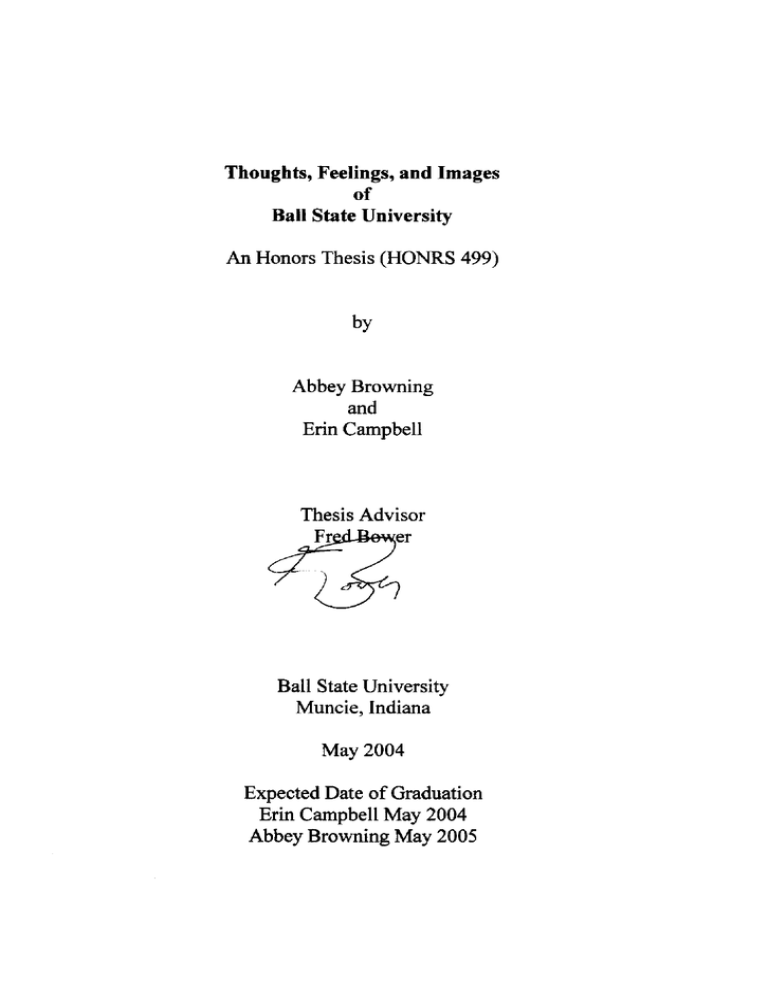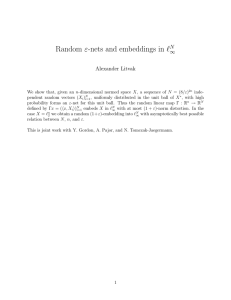Thoughts, Feelings, and Images of Ball State University Honors Thesis (HONRS 499)
advertisement

Thoughts, Feelings, and Images of Ball State University An Honors Thesis (HONRS 499) by Abbey Browning and Erin Campbell Thesis Advisor Fr er Ball State University Muncie, Indiana May 2004 Expected Date of Graduation Erin Campbell May 2004 Abbey Browning May 2005 ihcs! S i .:1:.' 7i LiS g Abstract , Z 1.J c9-0 0 1-/ P, ,_ '7:0 The development of our book, Thoughts, Feelings, and Images of Ball State University, included selection of subject matter, gathering imagery and alumni quotes, the creation of paintings based on the imagery, scanning and manipulation of the paintings, experimentation with printing processes, and exploration of book binding techniques. The finished product represents not only our thoughts and feelings about Ball State, but hopefully encompasses what we all might feel about our time at Ball State. We hope that we have created more than just images of Ball State, but an emotionally meaningful look at a place that is important to many people. Acknowledgements We would like to thank Mr. Fred Bower for his help as our advisor. We would like to thank Bob Browning, Jeannine Browning, Sue McColley, Dick Isenhour, Tony Schneider, and Jan Wanstrath for helping us complete our vision by taking the time to share their memories of Ball State with us. We would like to thank Bob Browning for his financial assistance with our project. Without him we would not have been able to afford the rising costs of printing and painting supplies! Authors' Note When we began working on our Thesis project, the vision that we had in our heads was very different from the finished product. This project has gone through an evolution of sorts, which led us to the creation of our book; Thoughts, Feelings, and Images ofBall State University. The finished book displays our skills in the areas of painting and graphic design. We started out with the idea of creating a children's book that would lead the reader on a sort of visual tour of Ball State University. As we started to work on our paintings and talk to friends and family about our project, we realized that a simple children's book of pictures didn't really express any deeper thoughts or feelings about Ball State. In the format that we began with, we could only scratch the surface of what we felt and what we heard other people saying about their experiences at Ball State. We decided to eliminate all of the historical information that we had gathered about the buildings themselves and really focus on what those buildings and places meant to people- what feelings and memories were attached to those physical places. So we went with that idea and began talking with people about specific memories that they had of their time at Ball State University. Once we had a significant number of quotes gathered, we started thinking about how we wanted to present these memories. We considered the idea of simply placing the quotes next to the scanned image of each painting. However, we felt that the effect was not very interesting and didn't really capture the feeling that we envisioned. We wanted to work more creatively on the graphic design aspect. After some time, we hit upon the idea of using the paintings as a base image and manipulating those images into a more abstract form. This idea is the one that we ultimately decided really captured what we had in our minds. It made sense to have less realistic, more abstract images ofthe places because the memories and feelings themselves are not concrete things, but abstract ideas. Another aspect of this project that took some brainstorming and problem solving was the printing process. Once we had the files created, we had to find someone who could print them. The problem that we found in this area is that we needed double sided, color prints with a bleed (color goes all the way to the edge of the page). Most standard at-home inkjets cannot do this. Generally when a real book is printed, they go to a larger printer that makes more than 1000 copies. In order to make just ten, as we were doing, we had to use a smaller, more public printer like Kinko's. At Kinko's they cannot print with a bleed at the size that we had. The solution to this problem, after much experimentation, was to slightly shrink the size of our page and cut off the excess white at the edges to achieve the effect of a bleed. Printing double-sided copies at Kinko' s was way too expensive and not always accurate. This forced us to print single sided and then glue the images back to back. Once we figured these things out, even the process of getting them printed was more complicated than we anticipated. We found that in the transfer of files from one computer to another there were often discrepancies causing us to go home, fix it, and then come back. By the end of the project we wished Kinko's was closer to our house and that we didn't know the Kinko's people quite so well. We assume they feel the same about us. After the printing problem was solved it was on to the binding. Our advisor was able to help us find the best method for binding the book. This included cutting the pages to size, layering them, attaching them at the fold, and gluing them to the cardboard cover. This process was a lot more labor intensive then we realized. To perfectly align everything required great precision and many mistakes on our part. This project was an amazing learning experience for us. Although sometimes the process was frustrating, when we put together that last book we had a great feeling of accomplishment and fulfillment. We feel that we succeeded in our goal and learned even more than we expected.





